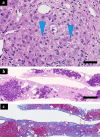Spur cell anemia related to alcoholic liver cirrhosis managed without liver transplantation: a case report and literature review
- PMID: 32472376
- PMCID: PMC7259740
- DOI: 10.1007/s12328-020-01142-3
Spur cell anemia related to alcoholic liver cirrhosis managed without liver transplantation: a case report and literature review
Abstract
Spur cell anemia is an acquired hemolytic anemia associated with liver cirrhosis and is characterized by the presence of increased large red blood cells, which are covered with spike-like projections that vary in width, length, and distribution. A 26-year-old man was referred to our hospital presenting with jaundice, lower limb edema, and dyspnea. The patient was subsequently diagnosed with spur cell anemia related to alcoholic liver cirrhosis. Spur cell anemia is an independent predictor of mortality in liver cirrhosis and has been associated with extremely poor prognosis. The most effective treatment for spur cell anemia is liver transplantation. As seen in the literature, the treatment of spur cell anemia without liver transplantation is quite challenging. This report highlights the importance of management and treatment strategies, including control of fluid retention, blood transfusion, plasma diafiltration, and administration of diuretics. Our treatment strategies might be useful in patients who are not candidate of liver transplantation or patients waiting for liver transplantation.
Keywords: Alcoholic liver cirrhosis; Case report; Liver cirrhosis; Plasma diafiltration; Spur cell anemia.
Conflict of interest statement
Takao Miwa, Yuichiro Hatano, Takahiro Kochi, Masashi Aiba, Katsuhisa Toda, Hideko Goto, Noriaki Nakamura, Naoki Katsumura, Kenji Imai, and Masahito Shimizu declare that they have no conflict of interest.
Figures






References
-
- Drolz A, Horvatits T, Roedl K, et al. Coagulation parameters and major bleeding in critically ill patients with cirrhosis. Hepatology. 2016;64:556–568. - PubMed
-
- Kalafateli M, Triantos CK, Nikolopoulou V, et al. Non-variceal gastrointestinal bleeding in patients with liver cirrhosis: a review. Dig Dis Sci. 2012;57:2743–2754. - PubMed
Publication types
MeSH terms
LinkOut - more resources
Full Text Sources
Medical
Research Materials

